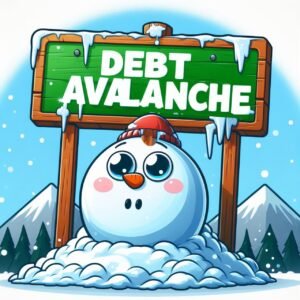Avalanche vs. Mountain: Understanding the Debt Avalanche
Debts can feel like insurmountable mountains, casting long shadows over our financial well-being. But just as every mountain has a path to the summit, so too does debt have strategies for conquer and emerge debt-free. Among these strategies, two distinct approaches rise like peaks: the Debt Avalanche and the Debt Snowball.

For those seeking the most efficient route, the Debt Avalanche beckons. Imagine it as a focused, tactical ascent, prioritizing the most daunting challenge first: high-interest debt. Unlike the scenic meandering of the Snowball, which targets the smallest balances regardless of interest, the Avalanche focuses on chipping away at those debts accruing the most financial “snow” in the form of compounding interest.
Peel back the layers to understand its principles, benefits, and even its potential dangers. You can transform the daunting “debt mountain” into a triumphant “debt-free peak.” We will equip you with the knowledge and tools you need to conquer your financial peak and enjoy the breathtaking view from the peak of your debt-free future.
Conquering the Summit: The Core Principles of Debt Avalanche
The Debt Avalanche isn’t just a catchy name; it’s a methodical climbing strategy with three core principles that guide your ascent:
Prioritizing the Peaks: Targeting High-Interest Debt First
Think of your debts as a range of mountains. The highest ones, with their steep slopes and treacherous icefalls, represent the debts with the highest interest rates. These are the “Everests” of your financial landscape, demanding your immediate attention. Why? Because every month, they accumulate the most interest snow, increasing your burden and hindering your progress.

The Avalanche approach tackles these formidable peaks first. Every extra dollar you can muster gets channeled towards crushing that high-interest beast. The logic is simple: the sooner you pay it off, the less interest you pay overall, saving you money in the long run.
Making Minimum Payments a Base Camp: Balancing Priorities
While focusing on conquering the highest peak, don’t neglect the lower hills. The Avalanche philosophy requires making at least the minimum payments on all your debts. Think of these payments as establishing secure base camps at the foot of each mountain. They prevent smaller debts from accumulating interest and ensure you maintain good standing with creditors.
Channeling Extra Resources: The Avalanche Fund and its Power
Your secret weapon in the Debt Avalanche is the Avalanche Fund. This pot of gold, fueled by additional income, bonuses, or savings, becomes your fuel for accelerated debt destruction. Every extra dollar you can throw into this fund is like an oxygen tank, propelling you closer to the summit.

Remember, the more you feed the Avalanche Fund, the faster you’ll be clearing those high-interest peaks.
Now, let’s see these principles in action with a real-life example:
Sarah has three debts: a credit card with a 20% APR ($5,000 balance), a personal loan with a 10% APR ($3,000 balance), and a car loan with a 5% APR ($8,000 balance). Following the Avalanche strategy, Sarah would:
- Make minimum payments on all three debts.
- Direct all extra income or savings towards the credit card with the highest interest rate.
- Once the credit card is paid off, roll the minimum payment and the Avalanche Fund money onto the personal loan, tackling it next.
- Finally, conquer the car loan with the combined forces of minimum payments and the Avalanche Fund.
By prioritizing high-interest debt and strategically using the Avalanche Fund, Sarah can save money on interest and reach debt freedom faster than if she simply made minimum payments on everything.
Scaling the Heights: Advantages and Disadvantages of the Debt Avalanche Approach
The Debt Avalanche isn’t just a theoretical concept; it’s a powerful tool for conquering debt, but like any tool, it has its strengths and weaknesses. Let’s explore the advantages and disadvantages to help you decide if it’s the right path for your financial climb.

Advantages:
• Saving Money on Interest: This is the Avalanche’s crowning jewel. By prioritizing high-interest debt first, you pay less interest overall. Imagine it as clearing snowdrifts before they bury your budget; you prevent them from growing and impacting your financial future.
• Faster Debt Freedom: This strategy cuts through debt like a hot knife through butter. By focusing on the most expensive burden first, you clear it out of the way, making faster progress and reaching debt freedom sooner. Think of it as reaching the summit before the blizzard hits, enjoying the clear skies of a debt-free life.
• Building Momentum: Each conquered peak fuels your motivation. Seeing one debt disappear after another creates a domino effect, encouraging you to keep pushing towards the next challenge. Success breeds success, and the Avalanche uses each victory to propel you forward.
Disadvantages:
• Requires Discipline and Consistency: This is not a leisurely stroll through the financial meadows. The Avalanche demands commitment and the ability to stick to your plan even when faced with distractions or temptations. Think of it as scaling a steep ice wall; one slip could send you tumbling back down.
• Delayed Gratification: Seeing smaller debts vanish might take longer. While high-interest monsters get slayed first, lower-balance debts might linger, leading to a sense of slow progress. Imagine climbing a long, winding path before reaching the base of the main peak; patience is key.
• Psychological Challenges: Facing large balances early on can be daunting. Seeing a hefty credit card bill alongside an Avalanche budget might feel overwhelming. Think of it as traversing a narrow ledge with a dizzying drop below; emotional resilience is required.
Remember, the Debt Avalanche is not a one-size-fits-all solution. If you’re unsure about your ability to stay disciplined or you crave quick wins, the Debt Snowball, which focuses on paying off the smallest debts first, might be a better option.
Base Camp Essentials: Strategies and Tools for a Successful Avalanche
The Debt Avalanche is a powerful weapon, but like any weapon, it needs proper handling and the right tools to be truly effective. In this we’ll equip you with the base camp essentials you need to navigate your ascent successfully:
1. Debt Avalanche in Action: Fictional Examples and Case Studies
Seeing the Avalanche in action can be more inspirational than theory. Let’s dive into two case studies:
Case Study 1: Mark, the Disciplined Climber:
Mark, a young professional with $15,000 in credit card debt at 18% APR and $8,000 in student loans at 8% APR, chose the Avalanche. He made minimum payments on the student loans while channeling all extra income towards the credit card. Within 12 months, he eliminated the high-interest monster, saving over $2,000 in interest. He then turned his focus to the student loans, paying them off in another 18 months. Mark’s discipline and strategic use of the Avalanche propelled him to debt freedom in just two years.
Case Study 2: Sarah, the Strategic Planner:
Sarah, a single mom with $7,000 in personal loan debt at 15% APR and a car loan at 5% APR, knew the Avalanche could be emotionally challenging. To combat this, she created a visual debt tracker, charting her progress and celebrating each milestone. She also automated transfers to her Avalanche Fund, ensuring consistent fuel for her climb. While it took Sarah slightly longer than Mark due to lower incomes, the visual progress and automated saving helped her stay motivated and reach debt freedom within two and a half years.
2. Budgeting for the Hike: Tools and Techniques to Fuel Your Progress
Budgeting is the oxygen mask of the Debt Avalanche. Tools like budgeting apps, spreadsheets, or even pen and paper can help you allocate your resources effectively. Track your income and expenses, identify spending leaks, and prioritize Avalanche fund contributions. Remember, every extra dollar counts!
3. Avoiding Avalanches: Recognizing and Mitigating Risks along the Way
Even the most skilled climbers face unexpected hazards. Be aware of potential risks like unexpected expenses, income disruptions, or temptation to deviate from your plan. Have an emergency fund in place to weather financial storms, and remember, a temporary setback doesn’t mean abandoning the summit. Adapt your plan, adjust your pace, and keep climbing!
Reaching the Peak and Beyond: Maintaining Debt-Free Habits
You’ve done it! The final debt monster has crumbled, and you stand triumphantly on the summit of a debt-free future. The view is breathtaking, but remember, maintaining your financial peak requires more than just reaching it. In this we’ll explore strategies to keep you anchored in debt-free bliss:
1. Celebrating Your Victory: Recognizing Your Triumph and Enjoying the View
Take a moment to truly appreciate your accomplishment. This feat required commitment, discipline, and unwavering focus. Let the satisfaction of a job well done fuel your future financial decisions. Treat yourself to a small, guilt-free reward, but remember, don’t let a celebratory splurge snowball into bad habits.
2. Building Financial Defenses: Preventing Future Avalanches
Your debt-free summit isn’t the end of the journey; it’s the start of a new, secure path. Build financial defenses to prevent future avalanches:
- Emergency Fund: Maintain a safety net to weather unexpected expenses without resorting to debt. Aim for 3-6 months of living expenses to cushion financial blows.
- Automated Savings: Make saving a habit, not a chore. Set up automatic transfers to build long-term savings for goals, investments, or even a larger emergency fund.
- Debt Review: Regularly review your financial accounts and credit reports. Address any new debt promptly and avoid accruing unnecessary interest.
3. Sharing the Knowledge: Helping Others Find Their Path to Debt Freedom
Your climb wasn’t solo; countless resources and supporters helped you reach the summit. Now, become a guide for others. Share your story, your strategies, and your newfound financial wisdom. Inspiring others and helping them find their own debt-free path can be an incredibly rewarding experience.
This concludes our ascent through the Debt Avalanche. We hope this guide has equipped you with the knowledge, tools, and inspiration to conquer your own financial peaks. Remember, you have the strength, the resilience, and the resources to reach debt-free freedom. Just keep climbing!
Conclusion
Conquering debt is like scaling a mountain, and the Debt Avalanche is your powerful climbing strategy. This approach prioritizes high-interest debts first, chipping away at the most expensive burdens and saving you money on interest in the long run. While it offers significant advantages like faster debt freedom and momentum building, it also demands discipline and may lead to delayed gratification or psychological challenges. To navigate this effectively, equip yourself with tools like budgeting apps, real-life case studies, and risk mitigation strategies.
Remember, consistent progress and adaptation are key. Once you reach the summit of debt freedom, celebrate your victory, build financial defenses like emergency funds and automated savings, and share your knowledge to inspire others. Maintaining debt-free habits is a continuous journey, but with the right mindset and tools, you can enjoy the breathtaking view from the financial peak for years to come. So, adventurer, embrace the Avalanche, keep climbing, and never let debt bury your financial future again!
FAQ
Q 1. How can I celebrate my debt-free victory without falling back into bad spending habits?
Ans: Celebrating your debt-free victory should be savored, not sabotaged! Treat yourself to a small, guilt-free reward that aligns with your new values. Instead of a splurge, consider experiences like a hike or concert. Focus on creating memories, not fleeting thrills. Prioritize experiences over material possessions, and remember, the joy of being debt-free is the ultimate reward.
Q 2. What are some specific strategies I can use to build my emergency fund and other financial defenses?
Ans: Building financial defenses requires a multi-pronged approach. Start with an emergency fund. Aim for 3-6 months of living expenses by allocating a percentage of each paycheck and automating transfers. Utilize the Avalanche mindset and channel leftover funds into long-term savings buckets for specific goals like investments or a larger emergency buffer. Review your budget regularly to pinpoint areas for further savings and optimize your financial safety net.
Q 3. How can I effectively share my debt-free story and inspire others to achieve the same?
Ans: Sharing your debt-free story can be an impactful way to inspire others. Be authentic and transparent about your struggles and successes. Focus on relatable milestones and the practical strategies that helped you conquer debt. Consider starting a blog, joining online communities, or even giving talks to share your valuable insights. You never know who you might inspire with your journey!
Q 4. What are some resources I can use to maintain my financial education and keep learning about responsible money management?
Ans: To maintain your financial education, leverage various resources. Follow reputable financial blogs, read books on personal finance, and attend webinars or workshops. Stay informed about updates in the financial world to make informed decisions. Engage with online communities to share experiences and gain insights.
Usefull Resources
- National Endowment for Financial Education (NEFE): https://www.nefe.org/
- The Debt Snowball vs. Debt Avalanche: A Calculator for You: https://www.nerdwallet.com/article/finance/what-is-a-debt-avalanche
- The Automatic Millionaire by David Bach: https://www.amazon.com/Automatic-Millionaire-Expanded-Updated-Powerful/dp/0451499085

